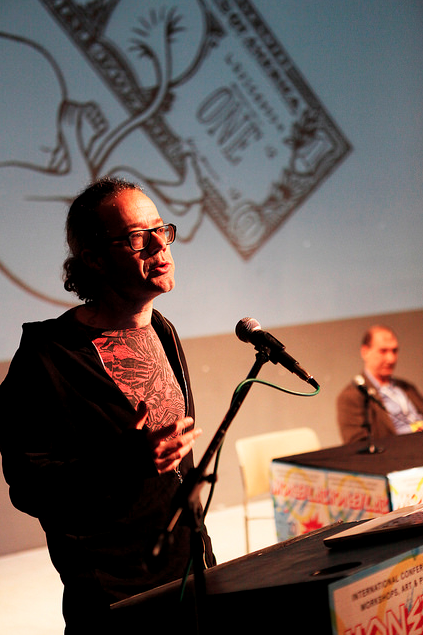Among the heteroclite crowd of scholars, artists, entrepreneurs and journalists intervening at MoneyLab comes Dadara, a man that could seem quite like a UFO after the finance-oriented morning of talks and conferences.
From underground culture promoter to bank director
The Amsterdam-based performance artist started his career as an illustrator, designing flyers and recording covers for the electronic house scene. Dadara claims he had no interest in money whatsoever until three years ago, but that he is now fascinated by it.
“Art was the only thing I cared about,” he says. It is only when he started reflecting on the value and monetization of art that the topic of money caught his attention, gradually taking a predominant role in his recent work.
“Most people, even though they use money every day, don’t think about it.” From 2010, Dadara found his new ambition: to make people think about money. And to do so, he did something quite surprising given his anti-money perspective: he created his very own monetary institution, the Exchanghibition Bank.
It is furthermore after realizing that “there wasn’t much money for art but a lot of money in banks,” that he decided to include money and banking in his art.
Gift economy meets love banknotes
His installation was first exhibited at several cultural spots such as the Rijksmuseum and the Stedelijk Museum in Amsterdam, before moving to more public spaces like Amsterdam Central Station.
More recently, Dadara performed at the Burning Man Festival, a choice that could seem odd at first, but is actually rather logical: the festival takes place each year in Nevada and relies only on a gift economy. The weeklong utopia’s inhabitants, therefore, were already quite receptive to a reflection on money.
“Money quantifies everything. Every value becomes a number. Why do we not appreciate spiritual or social value more? Why such a competitive drive?”
To illustrate his point, Dadara’s Exchanghibition Bank issues its own money: starting with zero and infinite bank notes, he then printed love bank notes. In his opinion, money has made most social exchanges so dramatically anonymous that we should try to add love to our payments as much as possible.
One of the aims of Dadara’s currency is to create dialogue, to encourage people to share stories while using the artist’s bills. While performing at Envision festival in Costa Rica, he realized that when he used his own banknotes, people would come up to him and start asking questions.
“Money doesn’t grow on trees,” they say
Another project of his is the Transformoney Tree, in which Dadara asked participants to glue dollar bills on the branches of a tree he had crafted and, if it pleased them, to paint and “make them pretty.”
By destroying money’s financial value, Dadara made it appear for what it truly is: pieces of printed paper rather than something inherently magical.
As he also writes on his blog:
“Our current form of currency has turned from a neutral medium of exchange into a belief system.”
Fun fact: drawing on money is considered a federal offense in the United States, and can legally result in a fine or up to six months imprisonment, or both.

One minute of silence… for all the time we waste
Perhaps reminding us of another well-known proverb, another of Dadara’s projects targets the value of time. To remind us that time is one of the most precious values on this planet, his bank now aims to issue time notes.
As Dadara amusingly says:
“Time should be considered as a quantitative value as much as anything else. In the past years, we’ve increased life expectancy to benefit more units of time. But how do we use them?”
To better emphasize his point, the Dutch performer wants to organize minutes of silence dedicated to wasted time, so people could contemplate how much of this resource they have lost. The artist also had a proper lawyer write down a contract for him, therefore legally stating that he, Dadara, is the entitled owner of his time.
The joys of crowdfunding: “money felt like a gift”
As most artists, however, Dadara’s relationship with money has sometimes been more practical. In 2002, with his project named the “Fools Ark”, he sent a ship he had crafted from the Netherlands to the US, so it could be burned there, again at Burning Man’s festival. This performance, he admits, financially ruined him for two years.
Therefore, the question of how to finance his work has probably often come to his mind, and the artist reckons he is quite enthusiastic when it comes to crowdfunding, which he sees as a kind of anarchism. “Money felt like a gift,” says Dadara, who has used such platforms to enable some of his new creations.
Dadara’s speech, compared to the down-to-earth talks of scholars, finance experts and entrepreneurs, appeared rather utopian, sometimes poetically naïve.
It reminds us that in the very complex world we live in and at a time where new technologies represent serious threats as well as inspiring hopes, we must remain idealistic, keep coming up with new solutions. Above all, we must keep dreaming.


